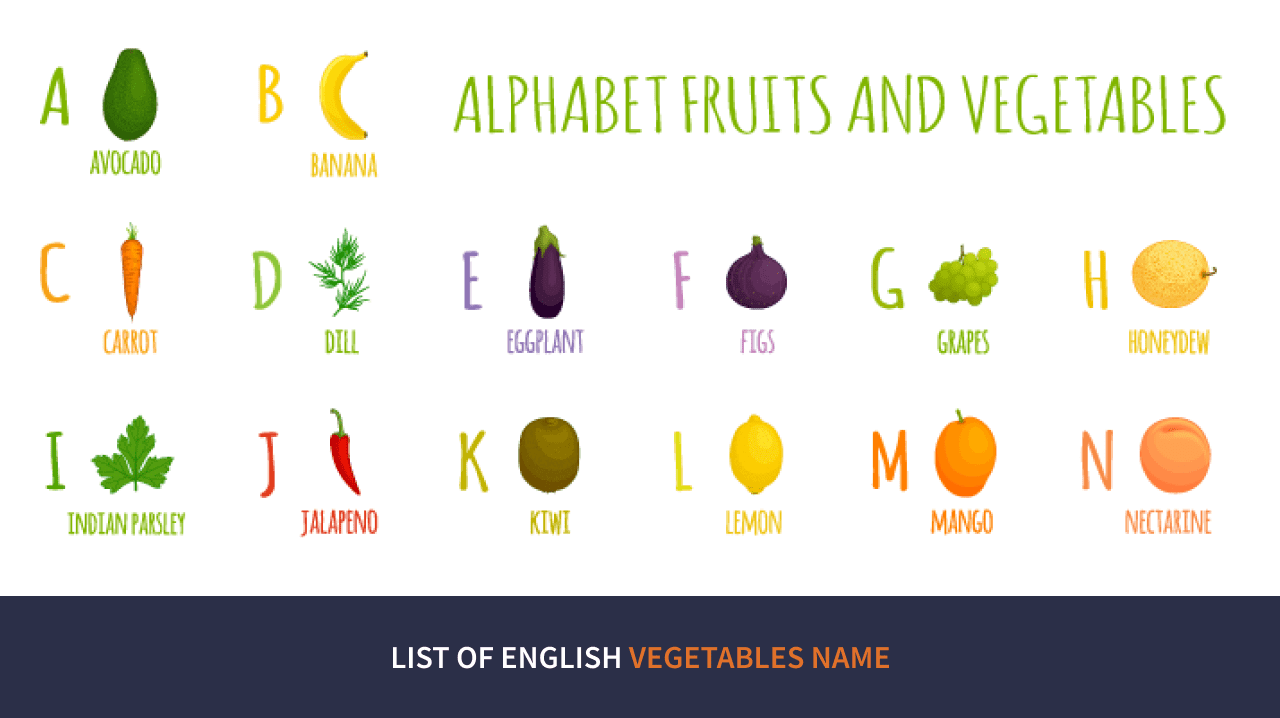List of English Vegetables Name

A scientific study has proven that children with the intake of vegetables from an early age are likely to have better gut health. Research has also shown that iron and folate present in green leafy vegetables are linked to better psychological health of students. So, vegetables are a full pack of nutrients including vitamins, minerals, and antioxidants, that are essential for the health and wellbeing of students. For instance, we all know that carrots contain vitamin A which prevents night blindness. Similarly, there is a whole big list of vegetables and their benefits. Some of the benefits include:
1. Healthier Digestion: Intake of vegetables improves digestive health. They are known to be a good source of dietary fiber and carbohydrates that help in the easy passage of food through the digestive system. Hence further helps in maintaining body weight.
2. Lesser Cardiovascular diseases: Vegetables like spinach and kale contain potassium that helps maintain the blood pressure of the body. That further reduces the risk of cardiovascular diseases.
3. Keeps the blood sugar controlled: Vegetables also help in preventing diabetes as they have low glycemic levels, which further prevents the sudden spike of glucose in the body.
4. Better psychological health: Including vegetables in the daily diet is also related to lesser stress and anxiety. That helps students perform better in academics.
5. Better immunity: Vegetable addition to the daily diet plan also improves the fighting ability of the body against outside bacteria and viruses.
Types of Vegetables
The following classification is based on the facts that which part of the vegetable is edile and used in the culinary preparations:
1. Flower Vegetables: These types of vegetables have flower-like or flower bud clustered appearance. They are known to have phytochemicals like isothiocyanates, that are known for preventing and building cancerous cells. Some of the flower vegetables are- cauliflower, broccoli, artichoke, zucchini flower, banana flower, squash blossom and many more. They are generally considered to be rich in various vitamins and minerals like folate, vitamins A, C, and K.
2. Leafy Vegetables: The green leafy vegetables that we mostly eat raw in salads like Spinach, lettuce, celery, cabbage, and many more are a complete package of multi-nutrients and vitamins. They have a good amount of vitamins like A, K, E, and C, and folate. They are also considered good to fulfill the bodily requirements of minerals like iron, magnesium, potassium, zinc, phosphorus, and sodium.
3. Root Vegetables: When the edible part of the plant is its root, it is called a root vegetable. Some of the examples include beetroot, carrots, turnips, radishes, yams, and more. Generally, root vegetables are rich in beta-carotene which is a precursor of Vitamin A that is known to reduce inflammation, and shielding the skin and eyes from damage caused by free radicals, and further prevent eye and skin disorders.
4. Tuber Vegetables: Stem tuber vegetables are plants that store fruit in the underground stems. Some of the best examples of stem tuber vegetables include ginger, turmeric potato, stem choke, and more. They are a great source of carbohydrates in the form of starch that supplies energy to the body.
5. Fruit vegetables: Cucumbers, pumpkins, avocados, tomatoes, peas, beans, and zucchini are a few examples of fruit vegetables. The main reason for calling them fruit vegetables is that we eat the fleshier part of the plant surrounding the seeds. However, in the culinary world, they are considered to be vegetables rather than fruits. They are a good source of antioxidants that help fight the free radicals in the human body.
6. Bulb vegetables: When we eat the modified leaf shoot with scales and buds, it is called bulb vegetables. Onions, garlic, leeks, and shallots are examples of Bulb vegetables. These are highly aromatic plants that are mainly used in the preparation of Asian curries and soups.
7. Stem vegetables: Asparagus, lemon grass, celery, kohlrabi, celtuce, rhubarb, swiss chard, and cardoon are examples of stem vegetables. In these types of vegetables, we consume the shoot part of the plant. They are mainly used in the preparation of sandwiches and soup.
List of nutrients present in the vegetables
During the growing years of a child, it is crucial to keep their diet healthy and should have a balanced portion of carbohydrates, fats, minerals, and vitamins. Vegetables play a major role in offering major and minor nutrients needed by a child’s body. Here is the list of nutrients:
- vitamin A (beta-carotene)
- vitamin C (L-ascorbic acid)
- vitamin E (alpha-tocopherol)
- magnesium
- zinc
- phosphorous
- folic acid.
List of English Vegetables Name:
- Potato
- Tomato
- Onion
- Cabbage
- Cauliflower
- Lady Finger
- Broccoli
- Beans
- Pumpkin
- Radish
- Garlic
- Turnip
- Carrot
- Brinjal
- Peas
- Capsicum
- Spinach
- Zucchini
- Elephant Yam
- Corn
Hopefully, the above vegetables name in English will help students.
If you are a parent and are tired of searching the internet with the terms best international baccalaureate program school or best international schools in Pune, then your search is over as MIT Vishwashanti Gurukul has been raking under the top 10 International schools in India for the past 15 years. This fact reflects our continuous dedication and zeal to offer the best quality education to our students through the Guru-Sishya Parampara. At MIT Vishwashanti Gurukul we have both day-school and boarding facilities for our outstation students. For the overall development of the well-being of the students, we have also included special classes for meditation and yoga in their daily schedules. We cater to students from 3 years to 19 years. We believe in providing conceptual understanding through the experiential learning process.

